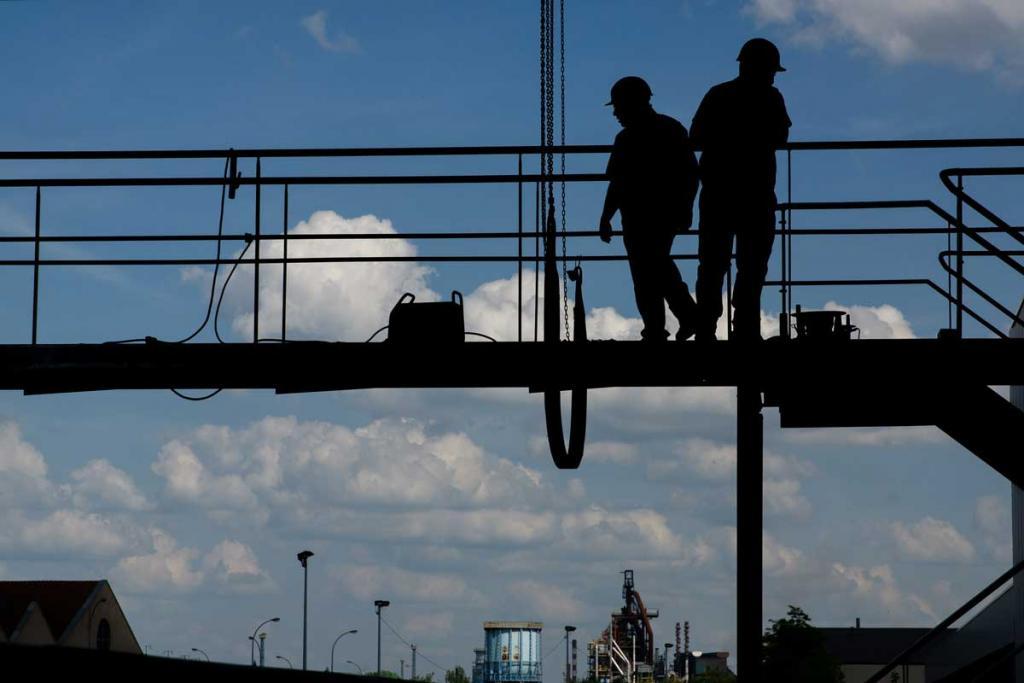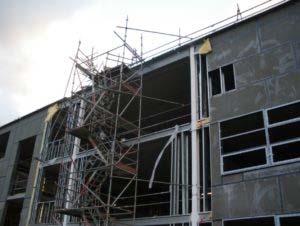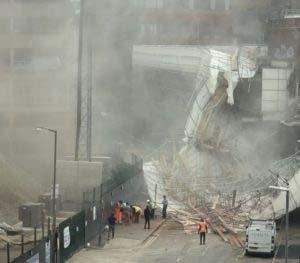Working at Height
Working at Height – Guidance for the employer
Latest statistics from the HSE reveal that, although falls from height are reducing, they are still one of the most common causes of injuries to employees and account for 29% of fatalities in the workplace. Employers are taking their responsibilities very seriously, not least because of the risks to a business, but also the number of lost working days every year as a result of injuries from falls from height.
But there are still too many deaths and injuries from falling so, this week I thought that I would look at the topic of working at height and guide employers as to their duties

Working at Height – Guidance for the employer
Working at height is defined as:
‘work in any place, including a place at or below ground level, or obtaining access to or egress from such a place, while at work, except by a staircase where, if suitable measures were not taken, a person could fall a distance likely to cause personal injury’.
Some facts
- Over three million people in the UK work at height as part of their job
- over 2,670 employees suffered a specified (major) injury, as a result of a fall from height in 2016/17, this resulted in 25 fatalities
- ladders are probably the most used and misused pieces of access equipment
- the vast majority of ladder accidents occur because the ladder is not secured at the top
- work at any height can cause injury; a fall from a height of just one or two steps can cause serious injury
- unsuitable access equipment (such as chairs and tables) can cause serious accidents even in low risk premises such as offices and schools
- it is particularly important to ensure that contractors working on an organisation’s premises (for example for roof maintenance or window cleaning) are properly controlled and do not work in a dangerous way.
Hierarchy of risk control
- Avoid working at height wherever possible by altering the task or the way it can be carried out
- if this is not reasonably practicable, the next step is to use equipment or other control measures to prevent falls
- always consider collective fall prevention measures, such as edge protection, over personal protection, such as harnesses
- if the potential for a fall remains, reduce the likelihood of injury by minimising the distance to fall or its consequences and always consider passive protection, such as safety netting, over active measures, such as having to clip a safety harness on to a structure
- in lower risk premises, take account of how storage areas and high shelving or wall displays are accessed.
Guidelines for Employers
Plan, organise and supervise all work at height
ensure employees are appropriately trained in safe working methods and the equipment to be used
make sure all those involved are competent and trained
assess the risks and ensure that appropriate work equipment is selected and used correctly
manage the risks from fragile surfaces, such as thin roofing materials or skylights
inspect and maintain all equipment and workplaces intended to control the risks of working at height
take account of weather conditions
ensure planning includes arrangements for emergencies and rescue
manage risks from falling objects.
“Plan, organise and supervise all work at height”
Recommendations for employers
Determine if the work involves a risk of a fall that could cause personal injury
consider if the work can be avoided by undertaking it in a different way
if it must be undertaken, determine the reasonable control measures that need to be used
ensure that there is a risk assessment covering the work activities
devise a safe system of work (ideally written down)
ensure that all workers are aware of the safe system of work and are trained in correct use of the safety equipment provided
for high risk work, consider a permit-to-work system
ensure that equipment is subject to statutory inspections at the required frequencies
supervise to ensure that the work is completed in accordance with the safe system of work
ensure that all workers are safe and clear of the work area before closing the job and putting premises and equipment back in service.
Legislation and guidance
- The Work at Height Regulations 2005 (as amended) apply to all work at height when there is a risk of a fall liable to cause personal injury. Duties are placed on employers, the self – employed and any person who controls the work of others (eg facilities managers or building owners who employ contractors to work at height).
- Where the means of making the work at height safe involves fixing points, such as eye bolts, running wires, fixed rail etc, there are legal requirements under the Lifting Operations and Lifting Equipment Regulations 1998 (LOLER) or the Provision and Use of Work Equipment Regulations 1998 (PUWER), for them to be subject to be suitably inspected. In the case where people are suspended or lifted there are specific requirements for thorough examinations at no more than six monthly intervals with inspection records being retained.
Help available from The Wilkins Safety Group Ltd
Here at the Wilkins Safety Group we can help clients with:
- Ladders – inspection and maintenance guidance
- WSG Guide on Working at height checklist – Work at height Competence checklist Work at height contractor Risk Assessment
If you would like any further help or support, please please contact us by phone 01458 253682, email or via our Facebook page or by Twitter.
We have courses in some foreign languages
Do you employ foreign workers who perhaps struggle to fully understand courses in English? Well we are trying to help by having some courses written in other languages.
At the moment the following foreign language courses are available:
- Latvian Health & Safety Induction
- Polish Health & Safety
- Polish Food Hygiene
- Romanian Health & Safety Induction
What is the cost of these courses?
Companies will be able to buy credits. Each of these credits will allow 1 allocated person access to 1 course. The cost of these credits will reduce based on the number of credits purchased. See pricing chart below:
| No of credits | 1-5 | 6-10 | 11-20 | 21-30 | 31-40 | 41-50 | 51-75 | 76-100 | 101-150 | 151-200 | 201-250 |
|---|---|---|---|---|---|---|---|---|---|---|---|
| Cost of credit | £19.99 | £17.99 | £16.99 | £15.99 | £14.99 | £13.99 | £12.99 | £11.99 | £10.99 | £9.99 | £7.99 |
Remember – There is no limit on the time it takes to use the credits
Director blown off roof during storm
Construction firms fined after director blown off roof during storm
A construction company and two roofing contractors have been ordered to pay almost £400,000 in fines and costs after the director of one of the firms fell 11 m when he was blown off a roof during Storm Doris in 2017. 
Bowmer and Kirkland, Advanced Roofing and JKW Roofing Services were working on a new three-storey teaching block at Abbotsfield School for Boys in Hillingdon, west London, when the accident happened on 23 February 2017.
Westminster Magistrates’ Court was told that, because of 94 mph winds, there were several warnings on site and many activities had been suspended.
However, the roof works continued until early that afternoon, when the director of JKW Roofing, John Whitham, was blown off the roof along with freestanding A-frame barriers and stacks of insulation.
The 52-year-old sustained severe injuries to his pelvis, back and leg.
Bowmer and Kirkland was the principal contractor. The roofing works were contracted to Advanced Roofing, which subcontracted some of the works on the main building to JKW Roofing.
An investigation carried out by the Health and Safety Executive (HSE) found all three companies had failed to properly assess the risk of high winds during work at height.
It said they had taken an “informal approach to assessing weather conditions which was not in line with industry standards”.
Bowmer and Kirkland pleaded guilty to breaching reg 4(3) of the Work at Height Regulations. It was fined £350,000 and ordered to pay £6,190 in costs.
Advanced Roofing was handed a £29,300 fine plus £6,188 costs after it admitted breaching reg 4(3) of the same regulations.
JKW Roofing, which pleaded guilty to the same breach, was handed a 12-month conditional discharge and ordered to pay £6,160 in costs.
HSE inspector Gabriella Dimitrov said:
“If a suitable safe system of work had been in place prior to the incident, the life-changing injuries sustained by Mr Whitham could have been prevented.”
Scaffolding collapses in Reading
Three injured as scaffolding collapses in Reading
‘Urgent inquiry needed’ says Unite, as Firefighters confirm nobody was trapped under scaffolding which collapsed at the site of an old shopping centre in Reading.
Firefighters used thermal imaging equipment to look for survivors, with Royal Berkshire Fire and Rescue Service confirming on social media that is ‘being supported by an Urban Search and Rescue Team (USAR) from Bucks & MK Fire’.
The incident occurred shortly after 11:15 on Thursday 1 August in Garrard Street. It has been reported three people, including a site worker and two passers-by, have been injured and taken to hospital with minor injuries.
Incident commander for South Central Ambulance Service, Tony Heselton, said the worker suffered a head injury. The other injured parties were a couple, one of whom suffered an ankle injury and the other was in suspected shock.
Upwards of ten calls were received to report the incident.
Royal Berkshire Fire and Rescue Service said that is sent five crews to the scene and advised the public to avoid the area.
The site, described locally as one of Reading’s ‘worst eyesores’, is being demolished as part of a major redevelopment in Reading town centre.
Urgent inquiry needed
In order to learn the lessons from the collapse, trade union Unite believes that the HSE must swiftly undertake an open and transparent inquiry into the collapse.
Unite National Officer Jerry Swain said:
“Everyone must be very grateful that the injuries reported so far have not been serious. If fatalities have been avoided, that is only through luck.
“A full inquiry must not just include the immediate reasons for the scaffolding collapse but also examine whether the work had been sub-let, were all workers on site properly employed, and did they all have the appropriate skills and training.
“It is essential that we learn the lessons from this accident to prevent similar serious incidents in the future.”
Remember
Unlike other organisations who send out newsletters giving you a little titbit of information, then stating that if you want to follow the full link or read the full story or get more information you must pay to subscribe to their service.
- Our newsletter service is FREE,
- The links we supply are FREE,
- The helpline advice is FREE.

If you find this newsletter service of use and you think others might also find it useful, then kindly pass it on and ask them to subscribe for free, so they can continue to receive it in their own right.
Also contact us if you have a particular health and safety subject or question you would like covered
If you have any queries on any health and safety matter, please contact Jon Wilkins on 01458 253682 or by email on [email protected]


